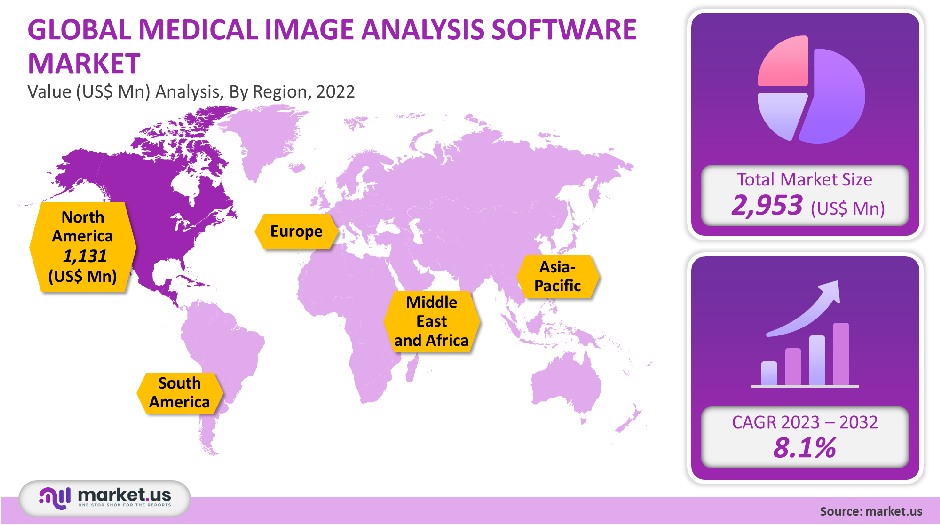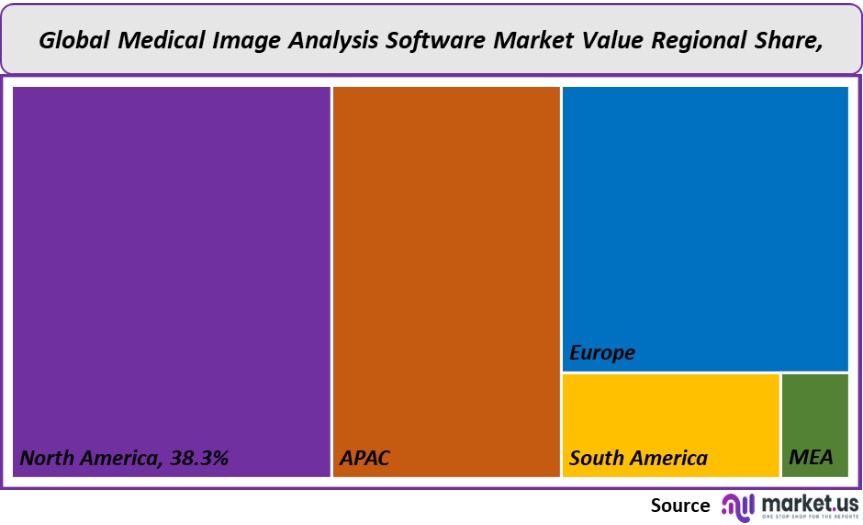Global Medical Image Analysis Software Market By Software Type (Stand-alone Software and Integrated Software), By Modality (Ultrasound Imaging, Tomography, Combined Modalities, and Radiographic Imaging), By Imaging Type (4D Imaging, 3D Imaging, and 2D Imaging), By Region and Companies - Industry Segment Outlook, Market Assessment, Competition Scenario, Trends and Forecast 2022-2032
- Published date: Oct 2021
- Report ID: 14351
- Number of Pages: 304
- Format:
- keyboard_arrow_up
Medical Image Analysis Software Market Overview:
The global medical image analysis software market accounted for USD 2,953 million in 2021. It is forecast to rise at a CAGR of 8.1% over the forecast period.
The market is expected to grow due to a rise in demand for diagnostic imaging software for fields such as oncology and urology.
Demand will rise due to the increasing use of ultrasound imaging systems for faster diagnosis, especially of chronic diseases. The demand for these platforms will be boosted by ongoing developments in imaging technology such as Computer-aided Diagnosis. The market dynamics have changed in recent years with the introduction of Artificial intelligence (AI), in medical imagery. This is expected to influence future growth.
Global Medical Image Analysis Software Market Scope:
Software type analysis
With a revenue share greater than 55.2%, integrated software was the dominant market player in 2021. These solutions offer many benefits. This is why integrated software has such a high market share. This integrated toolkit can be used for many radiology applications, improving workflow.
Philip’s Xcelera Cardiology Information Management, for example, is an integrated imaging management software that allows single-point access and enhances clinical workflow. Such solutions contribute to the segment’s majority revenue share. The segment’s growth is expected to be fueled by the high adoption of integrated systems because of their benefits such as cost-effectiveness and centralized storage.
It is expected that stand-alone platforms will continue to grow. These platforms are more user-friendly than integrated solutions and can be used at a lower cost. These platforms offer more features and details. Researchers can use them to access and share research data. This improves their ability to diagnose, monitor, treat, and monitor disorders.

Modality analysis
The global market can be further divided by modalities into tomography (ultrasound imaging), radiographic imaging (radiographic imaging), and combined modalities. Because of its cost-effectiveness, the tomography segment held 34.2% of global revenue in 2021. Market growth will be accelerated by the introduction of dual-source CT scanners and AI-enabled CT scanners.
In the next few years, CT imaging software will be more in demand as advanced products are introduced. ClariPiInc, for instance, received FDA approval in 2019 for its AI-enabled CT scanner “ClariCT.AI”. In terms of revenue, radiographic systems were next.
The adoption of radiography x-ray systems has grown over the years due to their early introduction. Radiography is a procedure that uses x-rays. This can expose you to harmful radiation for a long time. Radiography has many benefits that outweigh the risks. This segment is expected to grow at a steady CAGR throughout the forecast period.
The fastest CAGR is expected for the ultrasound image analysis software segment during the forecast years. It has many benefits such as speed and accuracy. Ultrasound imaging is non-invasive, and it does not expose you to ionizing radiation. This is a key factor in the segment’s growth.
Imaging type analysis
In 2021, the 4D imaging segment held more than 46.1% of the market. The technological advances in 4D imaging technology will allow for accurate and efficient real-time visualizations of the human body. This eliminates distortion in procedures. 4D imaging allows for 3-dimensional image analysis and real-time movement. Due to the increasing adoption of these technologies, the 3D and 4D imaging market will experience lucrative growth rates over the forecast period.
The market is also growing due to the introduction of computer-aided diagnosis systems. In the next few years, the market will be driven by the introduction of new products and multimodality image platforms.
Key Market Segments
By Software Type
- Stand-alone Software
- Integrated Software
By Modality
- Ultrasound Imaging
- Tomography
- Combined Modalities
- Radiographic Imaging
By Imaging Type
- 4D Imaging
- 3D Imaging
- 2D Imaging
Market Dynamics:
AI-based solutions can be used in medical imaging for diagnosis, detection, image analysis, and clinical decision support. Although AI adoption is still in its early stages in MRI, and CT technologies, the rising demand for accuracy and efficiency and patient safety will likely boost the adoption of AI-enabled medicine imaging over the forecast period.
This is due to the increasing demand for technologically advanced products like multimodality imaging platforms, and 3D imaging, and the benefits that these systems offer such as high-resolution imagery, ease of use, and flexibility. Market growth is expected to be driven by the introduction of technologically advanced products as well as the development of efficient information management systems.
The emphasis on innovation in medical image analysis has also resulted in the implementation of specific measures. Medical image processing can also help with illness diagnosis, treatment, and early detection. It is considered one of the most innovative technologies to combat the COVID-19 epidemic.
Many AI, machine learning, and deep learning methods have been used in medical imaging processing. This will drive market growth. Due to rising patient outcomes and increasing demand for image analysis solutions, diagnostic and research centers will be key end-users. These segments had smaller revenue shares because they often outsource imaging services to hospitals.
Regional Analysis
North America was the dominant market in 2021, accounting for more than 38.3% of global revenue. This is due to the existence of well-established healthcare institutions with advanced diagnostic equipment, and favorable government initiatives to encourage the adoption of healthcare IT. The region’s market growth is also due to increased R&D investments as well as the presence of market leaders. MIM Software Inc. collaborated with Genesis Care, a provider of integrated cancer care worldwide, to increase patient access.
Genesis Care’s clinical team treats over 400,000 cancer patients in more than 440 locations across Australia, U.S.A, U.K, and Spain. These initiatives are expected to support regional market growth. Asia Pacific is expected to experience the second-fastest CAGR during the forecast period. This is due to the growing adoption of medical imaging software by healthcare professionals in the Asia Pacific.
Market growth is expected to be driven by the growing awareness of the benefits associated with these systems. The regional market growth is also being driven by rising healthcare spending and disposable income in countries like China and India.

Key Regions and Countries covered іn thе rероrt:
- North America
- US
- Canada
- Mexico
- Europe
- Germany
- UK
- France
- Italy
- Russia
- Spain
- Rest of Europe
- APAC
- China
- Japan
- South Korea
- India
- Rest of Asia-Pacific
- South America
- Brazil
- Argentina
- Rest of South America
- MEA
- GCC
- South Africa
- Israel
- Rest of MEA
Market Share & Key Players Analysis:
This industry is competitive, with only a few companies leading the global market. Technology is a driving force in the industry. Continuous R&D is being conducted to develop cost-effective diagnostic solutions. To gain an advantage over their competitors, they are using strategies such as partnerships, mergers and acquisitions (regional expansions), and new product development to create collaborative agreements and partnerships.

Маrkеt Кеу Рlауеrѕ:
- Bruker Corp.
- Toshiba Medical Systems Corp.
- Esaote, Inc.
- Merge Healthcare Inc.
- Xinapse Systems Ltd.
- Spacelabs Healthcare, Inc.
- ClaroNAv, Inc.
- MIM Software Inc.
- Aquilab GmbH
- Other Key Players
For the Medical Image Analysis Software Market research study, the following years have been considered to estimate the market size:
Attribute Report Details Historical Years
2016-2020
Base Year
2021
Estimated Year
2022
Short Term Projection Year
2028
Projected Year
2023
Long Term Projection Year
2032
Report Coverage
Competitive Landscape, Revenue analysis, Company Share Analysis, Manufacturers Analysis, Volume by Manufacturers, Key Segments, Key company analysis, Market Trends, Distribution Channel, Market Dynamics, COVID-19 Impact Analysis, strategy for existing players to grab maximum market share, and more.
Regional Scope
North America, Europe, Asia-Pacific, South America, Middle East & Africa
Country Scope
United States, Canada and Mexico, Germany, France, UK, Russia and Italy, China, Japan, Korea, India and Southeast Asia, Brazil, Argentina, Colombia etc.Saudi Arabia, UAE, Egypt, Nigeria and South Africa
Frequently Asked Questions (FAQ)
Q: What is the size of the Medical Image Analysis Software market in 2021?A: The Medical Image Analysis Software market size is US$ 2,953 million in 2021.
Q: What is the projected CAGR at which the Medical Image Analysis Software market is expected to grow at?A: The Medical Image Analysis Software market is expected to grow at a CAGR of 8.1% (2023-2032).
Q: List the segments encompassed in this report on the Medical Image Analysis Software market?A: Market.US has segmented the Medical Image Analysis Software market by geographic (North America, Europe, APAC, South America, and Middle East and Africa). By Software Type, market has been segmented into Stand-alone Software and Integrated Software. By Modality, market has been segmented into Ultrasound Imaging, Tomography, Combined Modalities, and Radiographic Imaging. By Imaging Type, the market has been further divided into 4D Imaging, 3D Imaging, and 2D Imaging.
Q: List the key industry players of the Medical Image Analysis Software market?A: Bruker Corp., Toshiba Medical Systems Corp., Esaote, Inc., Merge Healthcare Inc., Xinapse Systems Ltd., Spacelabs Healthcare, Inc., ClaroNAv, Inc., MIM Software Inc., Aquilab GmbH, and Other Key Players engaged in the Medical Image Analysis Software market.
Q: Which region is more appealing for vendors employed in the Medical Image Analysis Software market?A: North America accounted for the highest revenue share of 38.3%. Therefore, the Medical Image Analysis Software industry in North America is expected to garner significant business opportunities over the forecast period.
Q: Name the key areas of business for Medical Image Analysis Software?A: The US, China, Japan, India, Brazil, Germany, UK, France, Italy, Spain, etc., are key areas of operation for Medical Image Analysis Software Market.
Q: Which segment accounts for the greatest market share in the Medical Image Analysis Software industry?A: With respect to the Medical Image Analysis Software industry, vendors can expect to leverage greater prospective business opportunities through the integrated software segment, as this area of interest accounts for the largest market share.
![Medical Image Analysis Software Market Medical Image Analysis Software Market]() Medical Image Analysis Software MarketPublished date: Oct 2021add_shopping_cartBuy Now get_appDownload Sample
Medical Image Analysis Software MarketPublished date: Oct 2021add_shopping_cartBuy Now get_appDownload Sample - Bruker Corp. Company Profile
- Toshiba Medical Systems Corp.
- Esaote, Inc.
- Merge Healthcare Inc.
- Xinapse Systems Ltd.
- Spacelabs Healthcare, Inc.
- ClaroNAv, Inc.
- MIM Software Inc.
- Aquilab GmbH
- Other Key Players
- settingsSettings
Our Clients
|
Single User
$5,999
$2,999
USD / per unit
save 50% |
Multi User
$7,999
$3,499
USD / per unit
save 55% |
Corporate User
$12,999
$4,499
USD / per unit
save 65% | |
|---|---|---|---|
| e-Access | |||
| Data Set (Excel) | |||
| Company Profile Library Access | |||
| Interactive Dashboard | |||
| Free Custumization | No | up to 10 hrs work | up to 30 hrs work |
| Accessibility | 1 User | 2-5 User | Unlimited |
| Analyst Support | up to 20 hrs | up to 40 hrs | up to 50 hrs |
| Benefit | Up to 20% off on next purchase | Up to 25% off on next purchase | Up to 30% off on next purchase |
| Buy Now ($ 2,999) | Buy Now ($ 3,499) | Buy Now ($ 4,499) |









